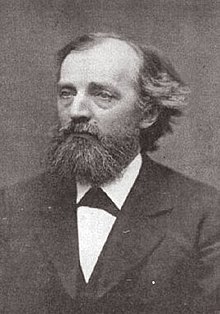Ezra Hervey Heywood (/ˈheɪˌwʊd/; September 29, 1829 – May 22, 1893),[1] known as Ezra Hervey Hoar before 1848,[2][3] was an American individualist anarchist, slavery abolitionist, and advocate of equal rights for women.
Ezra Heywood | |
|---|---|
 | |
| Born | Ezra Hervey Hoar September 29, 1829 United States |
| Died | May 22, 1893 (aged 63) United States |
| Occupation(s) | Activist, abolitionist |
| Spouse | Angela Heywood |
Philosophy
editHeywood saw what he believed to be a disproportionate concentration of capital in the hands of a few as the result of a selective extension of government-backed privileges to certain individuals and organizations.
He believed that there should be no profit in rent of buildings. He did not oppose rent, but believed that, if the building was fully paid for, it was improper to charge more than what is necessary for transfer costs, insurance, and repair of deterioration that occurs during the occupation by the tenant. He asserted the radical idea that it may be incumbent on the owner of the building to pay rent to the tenant if the tenant keeps his residency in such a condition that saved it from deterioration if it were otherwise unoccupied. Heywood believed that title to unused land was a great evil.
Activism
editHeywood's philosophy was instrumental in furthering individualist anarchist ideas through his extensive pamphleteering and reprinting of works of Josiah Warren, author of True Civilization (1869), and William B. Greene. In 1872, at a convention of the New England Labor Reform League in Boston, Heywood introduced Greene and Warren to eventual Liberty publisher Benjamin Tucker.
Heywood co-founded the New England Labor Reform League in 1869 with individualist anarchist William Batchelder Greene. The league advocated for the "abolition of class laws and false customs, whereby legitimate enterprise is defrauded by speculative monopoly." and favored "[f]ree contracts, free money, free markets, free transit, and free land".[4]
In May, 1872 Heywood, a supporter of women's suffrage and free love activist Victoria Woodhull's free speech rights, began editing individualist anarchist magazine The Word from his home in Princeton, Massachusetts.[5] He was tried in 1878 for mailing "obscene material", his pamphlet Cupid's Yokes: or, The Binding Forces of Conjugal Life: An Essay to Consider Some Moral and Physiological Phases of Love and Marriage, Wherein is Asserted the Natural Right and Necessity of Sexual Self-Government, which attacked traditional notions of marriage – at the instigation of postal inspector Anthony Comstock, who also had Truth Seeker editor D. M. Bennett arrested. Convicted of violating the 1873 Comstock Act, Heywood was sentenced to two years' hard labor[6] at the Norfolk County Jail.[7]
Unlike Bennett, Heywood was pardoned after six months by President Rutherford B. Hayes in response to massive protests by sympathizers and free speech advocates. Arrested four more times following his release, Heywood died of tuberculosis within a year of his final release from prison.
Temporal notation
editHeywood developed his own notation for years to be used in place of B. C. and A. D., namely B. L. and Y. L. respectively. He developed this notation on 2 July 1878 (Y. L. 6) because the A. D. notation "recognizes a mythical God in the calendar, puts Christian collars marked 'J. C.' on naturally free necks, and registers us subjects of the lascivio-religious despotism which the male-sexual origin and history of the cross impose".[8] He assigned 1873 'Y. L. 1' as that was the year of "the formation of the New England Free Love League in Boston".[8] Y. L. is notation for 'Year of Love'.[8] Thereafter, Heywood dated all of his correspondence and all issues of The Word with his new notation.[9]
Personal life
editHeywood met his wife Angela Heywood through her work in the abolitionist movement. They had four children together named Psyche, Angelo, Vesta, and Hermes.[10]
Works
edit- Uncivil Liberty: An Essay to Show the Injustice and Impolicy of Ruling Woman Without Her Consent (1873) by Ezra Heywood – one of the first individualist feminist essays, by Ezra Heywood (with an introduction by James J. Martin)
- Cupid's Yokes: or, The Binding Forces of Conjugal Life: An Essay to Consider some Moral and Physiological Phases of Love and Marriage by Ezra Heywood – a free-love essay defending the natural right of "sexual self-government" as opposed to marriage
See also
editReferences
edit- ^ The Letters of William Lloyd Garrison: From disunionism to the brink of war, 1850-1860, ISBN 0674526635, pg. 545.
- ^ Who was who in America. Marquis-Who's Who. 1963.
- ^ Blake, Francis Everett (1915). History of the Town of Princeton: In the County of Worcester and Commonwealth of Massachusetts, 1759-1915. Town.
- ^ D'Amato, David S. (2016-02-17). "William B. Greene, American Mutualist". Libertarianism.org. Retrieved 2022-08-21.
- ^ The Free Love Movement and Radical Individualism Archived 2011-06-14 at the Wayback Machine by Wendy McElroy.
- ^ Passet, Joanne Ellen (2003). Sex radicals and the quest for women's equality. University of Illinois Press. p. 45.
- ^ Parr, James L. (1 October 2009). Dedham: Historic and Heroic Tales from Shiretown. Arcadia Publishing Incorporated. p. 66. ISBN 978-1-62584-277-0. Retrieved 15 August 2019.
- ^ a b c E. H. Heywood, Cupid's Yokes (Princeton, Mass.: Co-operative Publishing Co.), p. 23, final note.
- ^ "Heywood, Ezra H." in The New Encyclopedia of UNBELIEF (Amherst, N. Y.: Prometheus Books, 2007), p. 389.
- ^ Sears, Hal D. (1977). The Sex Radicals. Lawrence, Kansas: The Regents Press of Kansas. p. 176.
Further reading
edit- Martin Blatt, Free Love and Anarchism: The Biography of Ezra Heywood (Chicago: University of Illinois Press, 1989)
- Martin Blatt, editor, The Collected Works of Ezra Heywood (Weston, MA: M & S Press, 1985)
External links
edit- Chapter V of James J. Martin's Men Against the State contains a large section called Ezra Heywood, Pamphleteer
- Ezra Heywood & Benjamin R. Tucker by Martin Blatt
- A biography of Heywood on the anniversary of a protest at his arrest
- A chronology of Emma Goldman's life and the anarchist movement